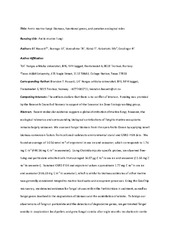Blar i forfatter "Vonnahme, Tobias R."
-
Arctic marine fungi: biomass, functional genes, and putative ecological roles
Hassett, Brandon Thomas; Borrego, Eli; Vonnahme, Tobias R.; Rämä, Teppo; Kolomiets, M.V.; Gradinger, Rolf (Journal article; Peer reviewed, 2019-02-11)Recent molecular evidence suggests a global distribution of marine fungi; however, the ecological relevance and corresponding biological contributions of fungi to marine ecosystems remains largely unknown. We assessed fungal biomass from the open Arctic Ocean by applying novel biomass conversion factors from cultured isolates to environmental sterol and CARD-FISH data. <br>We found an average of ... -
Effects of a deep-sea mining experiment on seafloor microbial communities and functions after 26 years
Vonnahme, Tobias R.; Molari, Massimiliano; Janssen, Felix; Wenzhöfer, Frank; Haeckel, Matthias; Titschak, Juergen; Boetius, Antje (Journal article; Tidsskriftartikkel; Peer reviewed, 2020-04-29)Future supplies of rare minerals for global industries with high-tech products may depend on deep-sea mining. However, environmental standards for seafloor integrity and recovery from environmental impacts are missing. We revisited the only midsize deep-sea disturbance and recolonization experiment carried out in 1989 in the Peru Basin nodule field to compare habitat integrity, remineralization ... -
Light and freshwater discharge drive the biogeochemistry and microbial ecology in a sub-Arctic fjord over the Polar night
Vonnahme, Tobias R.; Klausen, Line; Bank, R.M.; Michellod, D.; Lavik, G.; Dietrich, Ulrike; Gradinger, Rolf Rudolf (Journal article; Tidsskriftartikkel; Peer reviewed, 2022-09-30)The polar night has recently received increased attention as a surprisingly active biological season. Yet, polar night microbial ecology is a vastly understudied field. To identify the physical and biogeochemical parameters driving microbial activity over the dark season, we studied a sub-Arctic fjord system in northern Norway from autumn to early spring with detailed monthly sampling. We focused ... -
Methane-fuelled biofilms predominantly composed of methanotrophic ANME-1 in Arctic gas hydrate-related sediments
Gründger, Friederike; Carrier, Vincent; Svenning, Mette Marianne; Panieri, Giuliana; Vonnahme, Tobias R.; Klasek, Scott; Niemann, Helge (Journal article; Tidsskriftartikkel; Peer reviewed, 2019-07-05)Sedimentary biofilms comprising microbial communities mediating the anaerobic oxidation of methane are rare. Here, we describe two biofilm communities discovered in sediment cores recovered from Arctic cold seep sites (gas hydrate pingos) in the north-western Barents Sea, characterized by steady methane fluxes. We found macroscopically visible biofilms in pockets in the sediment matrix at the depth ... -
Seasonal Variability in the Zooplankton Community Structure in a Sub-Arctic Fjord as Revealed by Morphological and Molecular Approaches
Coguiec, Estelle; Ershova, Elizaveta; Daase, Malin; Vonnahme, Tobias R.; Wangensteen, Owen S.; Gradinger, Rolf; Præbel, Kim; Berge, Jørgen (Journal article; Tidsskriftartikkel; Peer reviewed, 2021-08-04)Phyto- and zooplankton in Arctic and sub-Arctic seas show very strong seasonal changes in diversity and biomass. Here we document the seasonal variability in the mesozooplankton community structure in a sub-Arctic fjord in Northern Norway based on monthly sampling between November 2018 and February 2020. We combined traditional morphological zooplankton identification with DNA metabarcoding of a 313 ... -
Tracing basal resource use across sea-ice, pelagic, and benthic habitats in the early Arctic spring food web with essential amino acid carbon isotopes
Vane, Kim; Cobain, Matthew R. D.; Trueman, Clive N.; Vonnahme, Tobias R.; Rokitta, Sebastian; Polunin, Nicholas V. C.; Flores, Hauke (Journal article; Tidsskriftartikkel; Peer reviewed, 2023-02-09)A rapidly warming Arctic Ocean and associated sea-ice decline is resulting in changing sea-ice protist communities, affecting productivity of under-ice, pelagic, and benthic fauna. Quantifying such effects is hampered by a lack of biomarkers suitable for tracing specific basal resources (primary producers and microorganisms) through food webs. We investigate the potential of δ<sup>13</sup>C values ...


 English
English norsk
norsk




